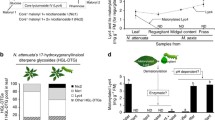Abstract
In the Chrysomelinae, it appears that de novo synthesis of chemicals for defense is the primitive state, and the sequestration of plant chemicals for defense the derived state. The derived state evolved through both the morphological and biochemical preadaptiveness of the homologous defensive glands. In the adults, we discuss one unique case of sequestration in exocrine defensive glands of host-plant pyrrolizidine alkaloids byOreina cacaliae. However, hypericin is not sequestered either in the glands or elsewhere in the body ofChrysolina spp. feeding onHypericum, which contradicts an earlier claim. In the larvae, we examine in more detail how the phenolglucoside salicin can be used as the precursor of the salicylaldehyde present in the defensive secretion ofPhratora vitellinae andChrysomela spp. with minimal changes in the biochemical mechanisms involved in the biosynthesis of iridoid monoterpenes in related species.
Similar content being viewed by others
References
Blum, M.S., Brand, J.M., Wallace, J.B., andFales, H.F. 1972. Chemical characterization of the defensive secretion of a chrysomelid larva.Life Sci. 11:525–531.
Boppré, M. 1986. Insect pharmacophagously utilizing defensive plant chemicals (pyrrolizidine alkaloids).Naturwissenschaften 73:17–26.
Daloze, D., Braekman, J.C., andPasteels, J.M. 1985. New polyoxygenated steroidal glucosides fromChrysolina hyperici (Coleoptera: Chrysomelidae).Tetrahaedron Lett. 26:2311–2314.
Deroe, C., andPasteels, J.M. 1977. Defensive mechanisms against predation in the Colorado beetle (Leptinotarsa decemlineata Say).Arch. Biol. (Bruxelles) 88:289–304.
Deroe, C., andPasteels, J.M. 1982. Distribution of adult defense glands in chrysomelids (Coleoptera: Chrysomelidae) and its significance in the evolution of defense mechanisms within the family.J. Chem. Ecol. 8:67–82.
Ferguson, J.E., andMetcalf, R.L. 1985. Cucurbitacins: Plant derived defense compounds for Diabroticites (Coleoptera: Chrysomelidae).J. Chem. Ecol. 11:311–317.
Matsuda, K., andSugawara, F. 1980. Defensive secretion of chrysomelid larvaeChrysomela vingitipunctata costella (Marseul),C. populi L. andGastrolina depressa Baly (Coleoptera: Chrysomelidae).Appl. Entomol. Zool. 15:316–320.
Pasteels, J.M., Rowell-Rahier, M., Braekman, J.C., andDupont, A. 1983. Salicin from hostplant as precursor of salicylaldehyde in defensive secretion of chrysomeline larvae.Physiol. Entomol. 8:307–314.
Pasteels, J.M., Rowell-Rahier, M., Braekman, J.C., andDaloze, D. 1984. Chemical defense in leaf-beetles and their larvae: The ecological, evolutionary and taxonomic significance.Biochem. Syst. Ecol. 12:395–406.
Pasteels, J.M., Braekman, J.C., andDaloze, D. 1988. Chemical defense in chrysomelidae, pp. 231–250,in P. Jolivet, T.H. Hsiao, and E. Petitpierre (eds.). The Biology of Chrysomelidae. Junk, Dordrecht.
Pasteels, J.M., Rowell-Rahier, M., andRaupp, M.J. 1989a. Plant-derived defense in Chrysomelid beetles,in P. Barbosa and D. Letourneau (eds.). Novel Aspects of Insect-Plant Interactions. Wiley, New York.
Pasteels, J.M., Rowell-Rahier, M., Randoux, T., Braekman, J.C., andDaloze, D. 1989b. Pyrrolizidine alkaloids of probable host-plant origin in the defensive secretion of the leaf beetleOreina cacaliae (Coleoptera, Chrysomelidae)Entomol. Exp Appl. 449:55–58.
Rees, J.C. 1969. Chemoreceptor specificity associated with choice of feeding site by the beetleChrysolina brunsvicensis on its food plant,Hypericum hirsutum.Entomol. Exp. Appl. 12:565–583.
Rowell-Rahier, M., andPasteels, J.M. 1982. The significance of salicin for aSalix-feeder,Phratora (Phyllodecta) vitellinae, pp. 73–79,in J.H. Visser and A.K. Minks (eds.). Proceedings of the 5th International Symposium on Insect-Plant Relationships. Pudoc, Wageningen.
Rowell-Rahier, M., andPasteels, J.M. 1986. Economics of chemical defense in Chrysomelinae.J. Chem. Ecol. 12:1189–1203.
Van Oycke, S., Braekman, J.C., Daloze, D., andPasteels, J.M. 1987. Cardenolide biosynthesis in chrysomelid beetles.Experientia 43:460–462.
Van Oycke, S., Randoux, T., Braekman, J.C., Daloze, D., andPasteels, J.M. 1988. New cardenolide glycosides from the defense glands of Chrysolinina beetles (Coleoptera: Chrysomelidae).Bull. Soc. Chim. Belg. 97:297–311.
Author information
Authors and Affiliations
Rights and permissions
About this article
Cite this article
Pasteels, J.M., Duffey, S. & Rowell-Rahier, M. Toxins in chrysomelid beetles Possible evolutionary sequence from de novo synthesis to derivation from food-plant chemicals. J Chem Ecol 16, 211–222 (1990). https://doi.org/10.1007/BF01021280
Received:
Accepted:
Issue Date:
DOI: https://doi.org/10.1007/BF01021280




